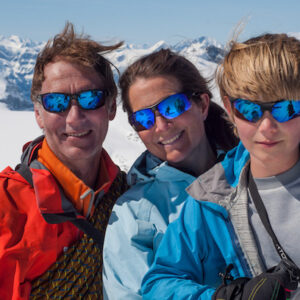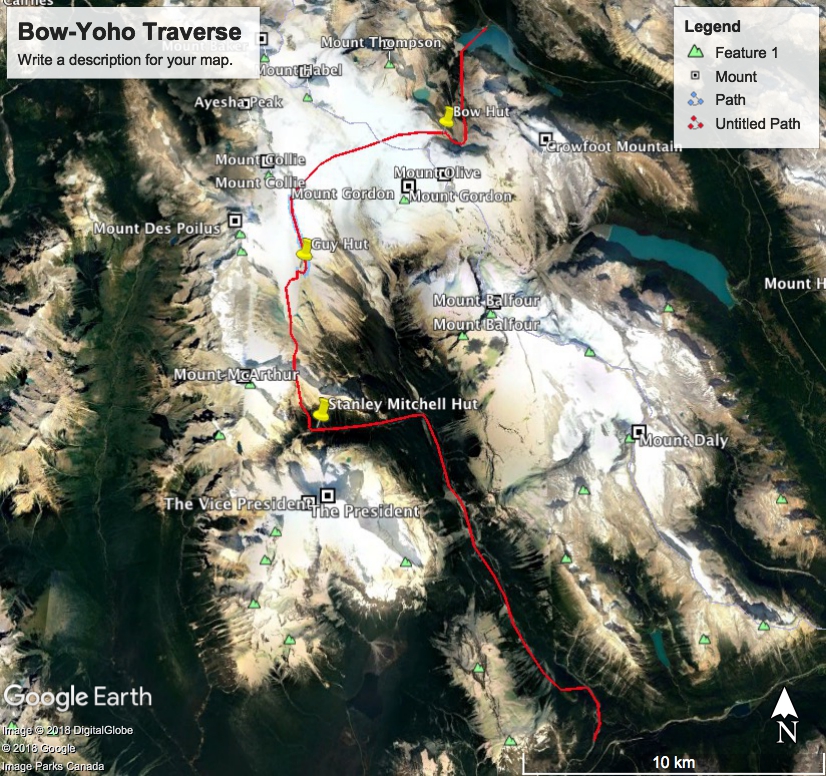- About the ACC
- Membership
- Huts
- Adventures
POLICIES & INSURANCE
- COMMUNITY
- Environment
- Shop
- Give
Crossing the Wapta Icefield east to west rather than north to south, the Bow-Yoho traverse is less publicized than the Wapta. But we have no idea why because this adventure offers the same great hut experience, exciting glaciated terrain and spectacular summits in arguably a more peaceful and isolated setting.
This route will take you over two additional glaciers (Yoho and des Poilus) to the Wapta Icefield, making it perfect for those who have been on the Wapta already and are seeking something new. The Yoho Valley is a particular gem, hosting iconic summits such as the President, Vice President, Mt. McArthur, fairytale log cabin accommodation (the Stanley Mitchell hut) and typically more powder than the Wapta. There’s a reason Chic Scott calls a visit here the “quintessential Canadian Rockies ski experience”.
Let us take care of everything from the huts, to the guiding, to the catering and and join us on a true ACC Adventure this winter!

BOOKING INFORMATION
Dates:
MARCH: 31ST – APRIL 6TH, 2024
Price: $2950.00+ TAX
Dates:
APRIL 13TH- 18 OR 19TH 2025
Price:
6 Day – $2600.00 +Tax
7 Day- $2950.00 +Tax
MORE INFORMATION
Please try to register online before calling. If you are having issues please try to have your emergency contact information and course questionnaire filled out before calling.
OR Call: (403)-678-3200 ext 213
Backcountry Skiing Hazards
Everyone on your camp will travel across the icefields together, but there is flexibility in the itinerary to accommodate individual objectives such as learning skills in glacial travel, bagging winter summits, completing a first major ski traverse, or even hunting powder.
There will be time and opportunities to summit some coveted peaks. Possible ski-mountaineering objectives include mounts Rhondda (3,055m), St. Nicholas (2,970m), Olive (3,130m), Gordon (3,202m), Collie (3,116m), Yoho (2,760m), Des Poilus (3,166m), McArthur (3,015m), Isolated Peak (2,823m), the President (3,138m) and Vice President (3,066m). Many of these mountains can be skied directly from the summit!
Other highlights of the trip include passing the beautiful Takakkaw Falls frozen in its winter coat, and the potential to ski both President’s Pass and the Iceline Exit from the Stanley Mitchell Hut.
The basic Bow-Yoho route could be completed by a strong party in 3 days, but our extended itinerary allows your group plenty of time for day trips to classic summits, passes and powder bowls, without your heavy pack. We think it’s these experiences which make the Bow-Yoho truly unique.
No previous mountaineering experience is required, however, you must have backcountry skiing/splitboarding experience and be able to comfortably ski the equivalent of blue/intermediate runs at downhill ski areas in variable conditions (powder, crust, icy etc.) with a heavy pack. Familiarity with touring equipment and the use of avalanche transceivers is also essential as is good all round fitness. You need to be capable of skinning uphill for several hours with a 35-40lb pack.
If you have any concerns about your suitability for this camp please contact the office before registering.
Evenings will be spent enjoying great food, socializing in cozy hut surroundings and resetting for the next day’s skiing. Food supplies will be carried in by porter to reduce pack weights and increase the quality and enjoyment of skiing. There will be a mix of lightweight but nutritious backpacking meals and snacks to keep you properly fuelled and hydrated for your adventure. All of our food is provided by specialized backcountry caterers based out of the Bow Valley. Check out our sample menu for full details of catering on ACC Adventures camps and courses.
Completing the Bow-Yoho wouldn’t be the same without also getting the full ACC hut experience. You’ll visit three very different styles of hut – the Bow, Guy and Stanley Mitchell – with two nights at each. The Bow Hut is by far the largest and most accessible of the huts, you can expect day and overnight trippers here and a social vibe. The Guy offers modern comfort in a spectacular location; until 2016, the traverse required camping at this location so this addition has made the traverse more accessible and comfortable for ski tourers. The Stanley Mitchell is a classic log-style, cosy cabin built in 1940. Staying here is an experience in itself with fantastic views across the mountains and communal and social dining. Guests will be expected to assist the guides with hut duties such as collecting snow for water helping with dishes.
Our ACMG certified ski guides will ensure your journey across the Wapta is both safe and enjoyable. Our guides will be welcome to answering questions about the region as well as everything from ski technique to gear. The maximum ratio of guides to participants will be 6:1 to ensure participants can travel at a pace which is right for them and have the chance to ask questions.
The ACC hires guides certified by the Association of Canadian Mountain Guides (ACMG). Visit the ACMG website to learn more about what they do!

DOUG LATIMER
Doug has 20+ years of guiding experience behind him as an ACMG ski guide and an ACMG apprentice rock guide. As well as his private guiding he has spent a number of years working for the UoC where he taught a range of instructional programs in avalanche training, crevasse rescue and backcountry ski and ski mountaineering. He also somehow finds time to run a multimedia production company! On top of all that, we are lucky to have Doug as our lead winter guide, where he shares his fantastic enthusiasm and extensive knowledge throughout our winter programs.


We sell Tugo® Travel Insurance suitable for both ACC Adventures and personal trips:
INCLUDED WITH YOUR CAMP FEE
PARTICIPANTS MUST PROVIDE
ORGANIZING FANTASTIC ACC ADVENTURES FOR OVER 100 YEARS
Input your search keywords and press Enter.